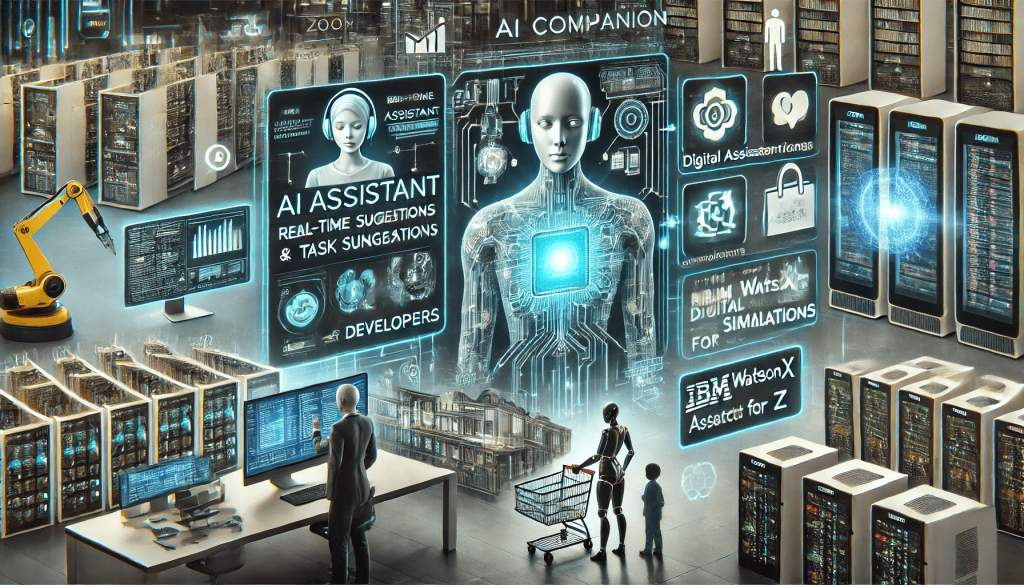The latest 3 AI innovation software
In 2024, several AI innovations are making waves across various industries. Here are some of the latest software developments:
- Zoom AI Companion 2.0: Zoom has upgraded its AI Companion to enhance productivity through advanced contextual understanding and action-taking capabilities. The tool integrates seamlessly across the Zoom Workplace platform, offering real-time web searches, intelligent suggestions, and the ability to complete tasks based on user interactions. Additionally, Zoom introduced a customizable AI Companion add-on that allows companies to personalize the tool using their unique data sources, improving workplace efficiency and collaboration (Zoom).
- IBM Watsonx AI Assistants: IBM has expanded its Watsonx suite with specialized AI assistants designed for specific business environments. For example, Watsonx Assistant for Z leverages domain-specific knowledge to aid mainframe operations, while Watsonx Orchestrate helps businesses build custom AI solutions using large language models (LLMs) tailored to specific enterprise needs. IBM has also incorporated natural language and low-code capabilities, enabling users to create AI assistants more intuitively (IBM – United States).
- Generative AI in Retail and Industry (NVIDIA): Companies like NVIDIA are developing generative AI solutions that revolutionize sectors such as retail and manufacturing. AI-powered shopping advisors provide personalized, human-like assistance, while industrial applications include using AI for designing and optimizing products through digital twins and 3D interoperability. This technology is also advancing vehicle production by allowing for virtual simulations and more interactive consumer experiences (NVIDIA Blog).
These innovations demonstrate how AI is being integrated across different fields, transforming work efficiency, customer engagement, and industry operations.

Here’s a breakdown of each AI innovation in detail:
1. Zoom AI Companion 2.0
- Overview: Zoom’s latest AI enhancement is the AI Companion 2.0, which is part of their AI-first work platform. It integrates across Zoom Workplace, offering real-time contextual support, personalized recommendations, and the ability to perform tasks like summarizing conversations or fetching relevant information.
- Features:
- Persistent Interface: The AI Companion stays active in a side panel throughout Zoom sessions, providing users with easy access to its features.
- Advanced Synthesis: It can pull data from Microsoft Outlook, Google Calendar, and other integrated applications to create summaries and suggestions.
- Task Automation: Zoom Tasks uses the AI Companion to detect, track, and complete tasks based on workplace communications, streamlining the user’s workflow.
- Customization: A new add-on offers advanced personalization, allowing integration with various third-party tools like Jira, Workday, and more.
2. IBM Watsonx AI Assistants
- Overview: IBM continues to innovate with its Watsonx suite, introducing AI assistants tailored for enterprise needs. The platform supports building custom solutions for domains like mainframe management and business automation.
- Key Developments:
- Watsonx Assistant for Z: This new generative AI tool is designed to support mainframe operations, leveraging IBM’s domain-specific expertise to help users manage complex systems through an intuitive, chat-based interface.
- Orchestrate Platform: It offers a low-code environment where users can create and deploy AI-powered assistants. The platform supports multiple languages and automates routing between assistants for more efficient task management.
- Conversational Search: This feature combines large language models with advanced search capabilities to deliver accurate, contextual responses quickly, boosting customer service and internal enterprise support.
3. Generative AI in Retail and Industry by NVIDIA
- Retail:
- Personalized Shopping Assistants: Retailers are using AI to create shopping assistants that simulate human interactions, providing tailored product recommendations and support based on the customer’s preferences. These tools are trained using extensive brand and product data to ensure that they maintain a high level of accuracy and relevance.
- Personalized Shopping Assistants: Retailers are using AI to create shopping assistants that simulate human interactions, providing tailored product recommendations and support based on the customer’s preferences. These tools are trained using extensive brand and product data to ensure that they maintain a high level of accuracy and relevance.
- Industrial Applications:
- Digital Twins and 3D Interoperability: In manufacturing, AI technology is used to create digital twins—virtual replicas of physical systems—to optimize design and production processes. This allows manufacturers to simulate, test, and validate products in virtual environments, reducing costs and improving efficiency.
- Automotive Innovations: Automakers employ AI to create photorealistic renderings for design reviews and virtual test drives. Additionally, AI assists in autonomous vehicle development by generating synthetic data and training models within 3D environments before deploying the technology on real roads.
These updates highlight AI’s expanding role across different sectors, improving everything from communication and business automation to retail customer experience and industrial efficiency.






